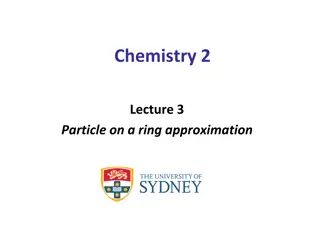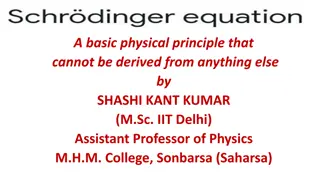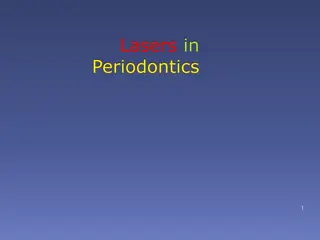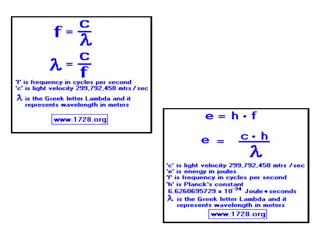Understanding Waves, Light, & Sound: Vocabulary and Concepts
This chapter covers essential vocabulary and concepts related to waves, light, and sound, including amplitude, crest, diffraction, Doppler effect, electromagnetic wave, frequency, interference, longitudinal wave, mechanical wave, medium, photon, pitch, reflection, refraction, sound wave, standing wa
8 views • 21 slides
Spectrophotometric Determination of Copper Sulfate Concentration
The experiment aims to determine the concentration of an unknown copper (II) sulfate solution by measuring light absorption at different wavelengths. Colored solutions absorb specific light wavelengths and appear colored to our eyes. By creating a calibration curve and following Beer's Law, the conc
3 views • 8 slides
Meticulous Research® Publishes In-Depth Analysis on the Laser Hair Removal Market
Laser Hair Removal Market Size, Share, Forecast, & Trends Analysis by product (Diode, Nd:YAG, Alexandrite), Wavelength (Multiple, Specific Standard), End User (Hospitals, Dermatology Clinics, Beauty Clinics, Home Setting), Sex - Global Forecast to 2031\n
0 views • 4 slides
Understanding Acoustical Transducers: Microphones and Loudspeakers
This tutorial explores acoustical transducers, focusing on microphones and loudspeakers. It covers transduction, principles of microphones and loudspeakers, as well as acoustics and psychoacoustics. Also discussed are the basics of sound, sound propagation, and the relationship between wavelength an
0 views • 33 slides
Understanding Fluorimetry: Principles and Applications
Fluorimetry is the measurement of fluorescence intensity at a specific wavelength using instruments like filter fluorimeters. It involves the excitation of molecules by radiation, causing electron promotion and emission of radiation. This process includes states like singlet and triplet, with relaxa
3 views • 45 slides
Exploring Quantum Theory and the Atom: Electrons in Atoms and the Periodic Table
Delve into the fascinating world of quantum theory and the atom in Chapter 9, where we compare Bohr's model with the quantum mechanical model. Understand de Broglie's wave-particle duality and Heisenberg's uncertainty principle's impact on our current electron view. Discover the relationships among
0 views • 31 slides
Understanding Electromagnetic Radiation and its Properties
This educational content delves into the arrangement of electrons in atoms, focusing on the properties of light and the electromagnetic spectrum, including the visible light spectrum. It explains wavelike behavior, wavelength, frequency, and their mathematical relationship, providing practice questi
0 views • 39 slides
Understanding Particle-on-a-Ring Approximation in Chemistry
Delve into the fascinating world of the particle-on-a-ring approximation in chemistry, exploring concepts like quantum quantization of energy levels, De Broglie approach, Schrödinger equation, and its relevance to the electronic structure of molecules. Discover how confining particles to a ring lea
1 views • 23 slides
Practical Physics Experiments for GCSE Force and Waves Concepts
Explore crucial GCSE physics practical experiments focusing on force, acceleration, extension of a spring, and wave properties in water and a solid. Understand the relationships between mass, force, acceleration, extension, frequency, wavelength, and wave speed through hands-on activities and data a
0 views • 5 slides
Understanding X-Ray Radiation: A Comprehensive Overview
X-ray radiation, discovered by Wilhelm Conrad Roentgen in 1895, is a high-energy electromagnetic radiation with a frequency range of 3.10^16Hz to 3.10^19Hz and a corresponding wavelength range from 0.01nm to 10nm. This form of radiation has applications in various fields, and its properties make it
0 views • 15 slides
Understanding Waves: A Visual Exploration
Explore the fascinating world of waves through visually engaging images and interactive clickers. Learn about different types of waves, including longitudinal and transverse waves, and discover what waves carry - energy, not matter. Delve into the concepts of mechanical and electromagnetic waves, an
1 views • 37 slides
Optical Properties of Optically Active Compounds
Circular dichroism and optical rotatory dispersion are important techniques for studying the optical properties of optically active compounds. Circular dichroism measures the differential absorption of left and right circularly polarized light components, while optical rotatory dispersion studies th
0 views • 17 slides
Spectrophotometric Determination of Cr and Mn in Steel Samples
This experiment aims to determine the concentrations of manganese and chromium in steel samples by converting Cr3+ and Mn2+ ions to light-absorbing forms, followed by spectrophotometric measurements at specific wavelengths. Steel samples are oxidized, dissolved, and further oxidized to form dichroma
0 views • 10 slides
Understanding UV/Visible Spectroscopy and Electromagnetic Radiation
Spectroscopy is the study of the interaction of matter with light, specifically UV and visible radiation. Electromagnetic radiation, consisting of photons, transmits energy through space as waves with oscillating electric and magnetic fields. The relationship between wavelength and frequency is key,
0 views • 50 slides
Understanding Electromagnetic Induction and Wave Characteristics
Explore the concept of electromagnetic induction, its explanation by scientists, and the presence of a black strip on your debit card. Discover the basic characteristics of waves, including amplitude, crest, trough, wavelength, phase, frequency, and speed. Dive into the world of waves and their ener
0 views • 99 slides
Exploring the 7 Key Characteristics of Sound Waves
Dive into the fascinating world of sound waves with an exploration of their 7 essential characteristics. Learn about attributes such as amplitude, frequency, phase, velocity, wavelength, harmonics, and envelope (ADSR), each playing a crucial role in shaping how we experience and interpret sound. Und
0 views • 8 slides
Fundamental Physics Principles Explored by Schrodinger and De Broglie
Shashi Kant Kumar dives into the groundwork laid by notable physicists such as Schrodinger and De Broglie, highlighting the fundamental principles of quantum mechanics. The evolution of Schrodinger's equation, the Nobel Prize-winning collaborations, and the application of wave mechanics to atomic st
0 views • 13 slides
Exploring Wave-Particle Duality in Electron Diffraction Experiment
Delve into the fascinating world of wave-particle duality through an electron diffraction experiment that reveals the dual nature of particles and waves. By investigating the wave characteristics of electrons and measuring their De Broglie wavelength, this experiment sheds light on the fundamental p
1 views • 12 slides
Understanding Monochromatic Plane Waves in Electromagnetic Theory
Explore the characteristics and properties of monochromatic plane waves in electromagnetic theory, including their spatial distribution, propagation in the positive X direction, wavelength, linear and non-linear operations, polarization direction, elliptical and circular polarization, and the relati
0 views • 15 slides
Introduction to Spectroscopic Instrumentation and Monochromators
Today's lecture covers spectroscopic instrumentation with a focus on monochromators. It delves into the components and performance measures of spectrometers, including wavelength discrimination filters, light detectors, and energy dispersive detectors. The dispersion of light through prisms and grat
0 views • 17 slides
Best Practices for Spectroscopy in JWST Missions
Explore key aspects such as wavelength coverage, spectral resolution, use of slits for faint targets, and choosing between different instruments like NIRSpec and MIRI for optimal results in time-series spectroscopy with JWST. Learn about the impact of apertures on precision and saturation limits for
0 views • 13 slides
GMACS for Scientists: Overview of GMT's Optical Spectrograph
GMACS (GMT Multi-Object Optical Spectrograph) is a cutting-edge spectrograph with a wide wavelength coverage and high resolution, designed for astronomical research. It features a field corrector/ADC system, onboard slit masks for object selection, and compatibility with MANIFEST for fiber optic ada
0 views • 5 slides
Exploring De Broglie Waves, Bohr's Quantization, and Electron Scattering in Physics
Discover the fascinating concepts of De Broglie waves, Bohr's quantization conditions, and electron scattering in physics. Delve into the wave-particle duality, electron double-slit experiments, and the groundbreaking observations by Davisson and Germer. Uncover the implications of mass particles ha
0 views • 23 slides
Understanding the Simple Double Beam Spectrometer
The simple double beam spectrometer is a vital instrument used to measure the amount of light absorbed by a sample at a specific wavelength. This device utilizes two light paths originating from the same source - one for the sample and the other for the reference. By splitting light beams, utilizing
2 views • 17 slides
Exploring the Dual Nature of Particles and Waves in Physics
This collection of images and information delves into the intriguing concept of the dual nature of particles and waves in the field of physics. From the historic Young's double-slit experiment demonstrating the wave nature of light to Louis de Broglie's groundbreaking work assigning a wavelength to
3 views • 15 slides
Understanding the Wave Theory of Light and Electromagnetic Spectrum
Explore the fascinating world of electromagnetic waves, visible light, and the wave theory through concepts such as wavelength, frequency, amplitude, and the speed of light. Understand how these elements are interconnected, and discover the diverse range of the electromagnetic spectrum. Dive into th
0 views • 77 slides
Understanding the Greenhouse Effect and Electromagnetic Radiation
The presentation delves into the science behind the greenhouse effect, explaining how human activities contribute to the enhanced greenhouse effect. It explores the composition of Earth's atmosphere, the role of greenhouse gases, and the impact of burning fossil fuels. Additionally, it covers the ba
0 views • 15 slides
Optical SDN/NFV User Guide for Network Control & Management
Explore the comprehensive user guide for Optical Software-Defined Networking (SDN) and Network Functions Virtualization (NFV) at the University of Arizona. Learn about the SDN controller interfaces, network monitoring, traffic engineering databases, and more. Discover the capabilities of the Northbo
0 views • 13 slides
Understanding Lasers in Periodontics: A Comprehensive Overview
Lasers play a significant role in periodontics, offering precise treatment with minimal discomfort. The technology involves light amplification, stimulation of photons, emission processes, and properties of laser light. Classification of lasers based on active medium types is explored, along with sp
0 views • 30 slides
Advances in Nanoparticle-Enhanced Photosensors for UV Light Detection and Quantum Confinement Research
Nanoparticle-enhanced photosensors are being developed by Steve Magill at Argonne National Laboratory for UV light detection, utilizing quantum confinement to enhance electronic and optical properties. Quantum confinement creates discrete energy levels in nanoparticles smaller than the electron wave
0 views • 30 slides
Exploring the Universe: X-Ray Surveys with Space Observatory
Delve into the fascinating world of X-ray surveys conducted by the Space Observatory at Khyung Hee University. Learn about the significance of X-ray surveys in detecting emission from hot regions of the Universe, minimizing errors in redshift measurements, extending the sample to higher redshifts, a
0 views • 16 slides
Quantum Chemistry Learning Goals and Concepts
This content covers the learning goals and concepts of quantum chemistry leading up to the Schrodinger equation and potential energy wells, excluding the material on the hydrogen atom introduced later. It explores models of the atom, including observations of atomic spectra, the Bohr model, de Brogl
0 views • 22 slides
Quantum Theory and Key Figures in Physics
Explore the evolution of quantum theory through the perspectives of renowned physicists such as Albert Einstein, Niels Bohr, Werner Heisenberg, Erwin Schrödinger, Prince Louis de Broglie, and Max Planck. Learn about atomic line spectra, fundamental equations, and models used to represent the atom.
0 views • 23 slides
Advances in Laser Plasma Acceleration and Strong Field QED Research
Exciting advancements in laser plasma acceleration using short wavelength drivers and strong field QED research are being made, with studies involving excimer lasers, electron beam pumping, and high-power amplifiers. Techniques like excimer multiplexing are explored for multi-stage laser wakefield a
1 views • 24 slides
Practice Problems on Wavelength, Frequency, and Energy
Solve problems relating to wavelength, frequency, and energy of electromagnetic waves. Calculate frequencies, wavelengths, and energies of light in various spectra including violet light and microwave radiation. Understand the relationship between wavelength, frequency, and energy in different scena
1 views • 7 slides
Understanding Electromagnetic Radiation and Quantum Energy in Chemistry
Delve into the fundamentals of atomic structure, periodicity, and electromagnetic radiation in chemistry. Explore the concepts of wavelength, frequency, speed of light, and quantum energy. Learn about important terms, example problems, Max Planck's contributions, and the photoelectric effect. Unrave
0 views • 67 slides
Resonance Phenomena in Grating Structures and Applications
Resonance phenomena in grating structures, such as dielectric or metal gratings on substrates, offer sensitive elements for detecting biological and chemical agents. The sensitivity of these structures is described by equations relating to resonant wavelength changes and the refractive index of inve
0 views • 20 slides
Understanding Multiband Systems in Broadband Communication
Explore the world of Wavelength Division Multiplexing (WDM) and its components, including fiber couplers, isolators, circulators, multiplexers, and demultiplexers. Learn the benefits of WDM technology such as capacity upgrade, transparency, scalability, and wavelength routing. Discover how WDM, CWDM
0 views • 51 slides
Understanding Electronic Structure and Quantum Theory in Atoms
Electronic structure and quantum theory elucidate the behavior and arrangement of electrons in atoms, with a focus on electromagnetic radiation, wavelength, frequency, and the speed of light. The inverse relationship between frequency and wavelength is explored through practical examples involving r
0 views • 34 slides
Insights into Nuclear Radius and Electron Scattering Experiments
Delve into the realm of nuclear physics with a focus on nuclear radii and electron scattering experiments led by lecturer Hans-Jürgen Wollersheim. Explore topics such as de Broglie wavelength, double-slit experiment, Mott scattering, charge distribution, and the use of electrons as probes to measur
0 views • 9 slides







































